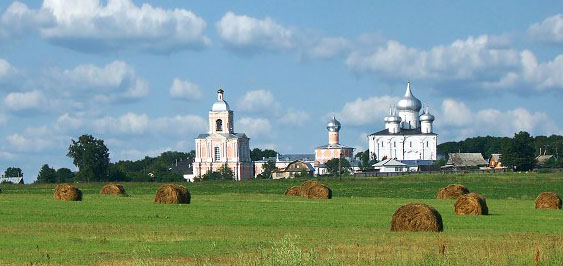

Location: Novgorod Oblast Map
Established: 1190
Khutyn Monastery of Saviour's Transfiguration and of Saint Varlaam (Хутынский Спасо-Преображенский Варлаамиев монастырь) is located in Novgorod Oblast of Russia. Khutyn Monastery of Saviour's Transfiguration and of Saint Varlaam was founded in 1190 in the isolated region of the country. Despite years of development and city growth this beautiful Eastern Orthodox monastery is still surrounded by pristine meadows and forests.
According to folk legend, this place was dominated by
evil spirits and was called "Khutyn", that is, a bad place. Here the
monk Varlaam (in the world Aleksa Mikhalevich) retired for prayer. One
day Prince Yaroslav came to him. Varlaam, blessing him, said "be
healthy, prince, and with your noble son." This greeting amazed the
prince, who did not yet know about the birth of the baby (this was in
1190). Having cut down a cell and having won a victory over the evil
spirits, he first erected a wooden and then a stone church in the name
of the Transfiguration of the Lord (Church of the Savior on Khutyn). The
church was consecrated on August 6, 1192 by Archbishop Gregory. The
temple has not survived. In 1515 the Transfiguration Cathedral was
built.
In 1471, John Vasilyevich the Third came to the Khutynsky
Monastery to venerate the holy relics, and, according to legend, he
began to ask the abbot why they did not open the shrines so that
everyone could venerate the holy relics. When, at his command, they
began to dig up the grave of the Monk Varlaam, a pillar of fire broke
out of the ground, scorching the wall and the south door of the
iconostasis. The Grand Duke fled in horror from the church, striking the
ground with his staff, and fire came out of the ground not only in the
church, but also in the monastery. Throwing away his staff, the Grand
Duke left the monastery in great fear. This staff and the scorched door
of the altar were kept in the monastery sacristy.
In the years
1553-1557, Markell Bezborody, a major hagiographer and the most
prominent chanter of the Novgorod school of the 16th century, was the
abbot of the monastery.
In 1611 the monastery became the
residence of the command of the Swedes who attacked Veliky Novgorod.
From the middle of the 18th century, the vicars of the Novgorod
diocese were the abbots of the Khutynsky monastery, who bore the title
of Keksholmsky and Ladoga (1759-1763), Starorussky (1787-1892),
Kirillovsky (1892-1907), Tikhvinsky (1907-1921).
The ashes of the
poet Gabriel Derzhavin and his wife Daria are buried in the
Transfiguration Cathedral. Derzhavin died in 1816 at the Zvanka estate.
The coffin with the body of the deceased was delivered to the monastery
on a barge along the Volkhov. Archbishop Anthony (Znamensky), Bishop
Sylvester (Tsvetkov) of Staraya Russa, and Bishop Arseniy (Ivashchenko)
of Kirillov are also buried in the monastery cathedral.
The
monastery was closed in 1925, but until 1932 services were still held in
the monastery cathedral. The title of Archbishop of Khutyn was borne by
Alexy (Simansky); in the cathedral in 1930-1932 the future Archimandrite
Pavel (Gruzdev) sang and read on the kliros.
During the Great
Patriotic War the monastery was destroyed and remained in ruins for more
than 40 years. Derzhavin's grave was also damaged. In 1959, the reburial
of the remains of the poet and his wife took place in Novgorod Detinets.
In 1993, in connection with the 250th anniversary of the poet, his
remains were returned to the monastery.
Since April 20, 1994, it
has been a functioning convent. The abbess is Abbess Alexia
(Simdyankina). As of January 2012, more than 100 sisters lived in the
monastery, there is a courtyard in the village of Bykovo, Valdai region.
Varlaam Khutynsky (1192);
Anthony Dymsky (1193);
Varlaam (1207);
Arseny (1230);
Isidore (1243);
Xenophon (1262);
John (1388);
Zacchaeus;
Joseph;
Tarasius (1440);
Leonty
(1460);
Nathanael (1471, 1476);
Herman (1479);
Sergei
(1508-1516);
Nicephorus (1517-1524);
Alexander;
Theodosius
(1531-1542);
Paisiy Kozlyatev (1551);
Theognost;
Gury Korovin
(1552);
Martyrius (1555);
Markell the Beardless (1555);
Philotheus (1556-1560, 1567);
Varlaam (1571, 1572);
Dionysius
(1577-1581);
Sylvester (1584-1591);
Arkady (1595-1598);
Joel;
Tryphon (1601-1609);
Ioanniky Maltsov (1890, 1891)
Paphnutius;
Cyprian (Starorusennikov) (1609-1620);
Varlaam (1621, 1624);
Theodosius (1624);
Theodoret (1629, 1635);
Raphael (1636, 1637);
Pachomius (1638-1641);
Evfimy (1642, 1646);
Varlaam (1648-1652);
Sophronius (1652, 1653);
Evfimy (1653-1657);
Tikhon (1658-1660);
Dionysius (1661, 1662);
Cornelius (1662-1664);
Joseph (1664-1672);
Pachomius (1673, 1674);
Macarius (1674-1678);
Gelasius (1679-1682);
Evfimy (1683-1689);
Macarius (1690-1695);
Job (1698);
Tikhon (1699-1704);
Theodosius (Yanovsky) (1704-1712);
Benjamin (1712-1737);
Gabriel (Voronov) (1738-1740);
Benedict;
Ephraim;
Triphilius (1747);
Damaskin (Ascaron) (1747-1751);
Sylvester (1755);
Joasaph (Mitkevich) (1756-1758);
John (Nikitin)
(1763-1764);
Anthony (Feofanov) (1764-1767);
Lavrenty (Baranovich)
(1767-1774);
Tarasy (Verbitsky) (1774-1775);
Arseny (Buzanovsky)
(1775-1782);
Theophilus (Raev) (1782-1788).
Parthenius (Sopkovsky) (1759-1761);
Tikhon Zadonsky
(1761-1763);
Innokenty (Nechaev) (1763);
Athanasius (Volkhovsky)
(1788-1795);
Dosifey (Ilyin) (1795-1798);
Arseny (Moskvin, Vasily)
(1798-1799);
Anthony (Znamensky) (1799-1802);
Mikhail (Desnitsky)
(1802-1803);
Eugene (Bolkhovitinov) (1804-1808);
Anthony (Sokolov)
(1808-1810);
Joasaph (Sretensky) (1810-1813);
Methodius
(Pishnyachevsky) (1813-1816);
Ambrose (Ornatsky) (1816-1819);
Damaskin (Rossov) (1819-1821);
Sylvester (Tsvetkov) (1821-1823);
Moses (Bogdanov-Platonov-Antipov) (1824-1827);
Ignatius (Semenov)
(1828);
Timofey (Kotlerov-Veshchezerov) (1828-1834);
Anastasy
(Klyucharev) (1834-1837);
Feodoty (Ozerov) (1837-1842);
Justin
(Mikhailov) (1842);
Leonid (Zaretsky) (1843-1850);
Nathanael
(Savchenko) (1850);
Anthony (Shokotov) (1850-1853);
Anthony
(Pavlinsky) (1853-1854);
Ioanniky (Gorsky) (1855-1856);
Plato
(Thebes) (1856);
Evfimy (Belikov) (1856-1860);
Feofilakt (Gubin)
(1860-1862);
Gerasim (Dobroserdov) (1863-1864);
Apollos (Belyaev)
(1864-1866);
Seraphim (Protopopov) (1866-1869);
Feoktist (Popov)
(1869-1874);
Nikodim (Belokurov) (1875-1876);
Varsonofy (Okhotin)
(1876-1882);
Anastasy (Dobradin) (1882-1888);
Vladimir
(Bogoyavlensky) (1888-1891);
Anthony (Sokolov) (1891-1892);
Nazariy (Kirillov) (1893);
Arseny (Ivashchenko) (1893-1903);
Theodosius (Feodosiev) (1903-1907);
Andronik (Nikolsky) (1908-1913);
Alexy (Simansky) (1913-1920).